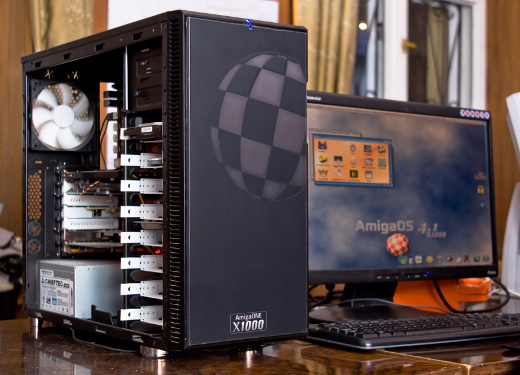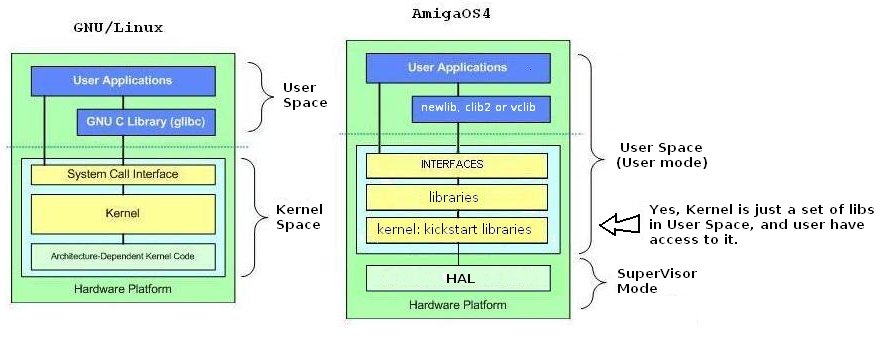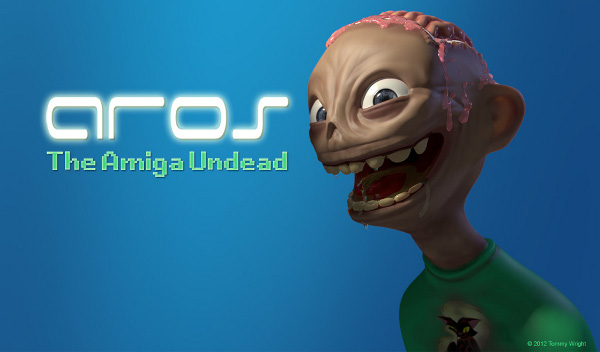
Amiga in 2012 - Present days
By kas1e@yandex.ru
1. Intro
2. AmigaOS4
3. MorphOS
4. AROS
5. Final
1. Intro.
If you ask any young person who uses a computer for social networking, casual gaming and just work and fun what "Amiga" is, then he almost all the time will know nothing about that old computer. Maybe some will remember from some articles that there was some computer which was very popular in the beginning and kicked the asses of all the other computers of those times (and it was like this indeed). But in general, today, almost no one will know about it. From time to time some enthuiasts and "we want to be different" freaks find some information and discover that there is still life, still a community, new Amiga and Amiga like OSes, new HW, different kind of software and co. Althrough it's all in a kind of stagnatic situation compared with the "real world", because without new blood there are no new programmers, almost no new users, and as a result the user base is shrinking year by year. Most of the current Amiga enthusiasts are at the 25-40 and more (up to 70) age ("the middle" line are 30-40 years) and that has kind of put a stamp on the whole spirit. Today Amiga and related stuff have hard and good times. Good times because everything is still alive (I do not know how it is possible, but is it): new HW, new OSes, new programs. But bad times because there are mostly no new users, and those new who come to the Amiga world pretty often don't stay long, because the Amiga OSes in general aren't mature, because of the unprofessionalism in many areas and because there are no commercial compaines who make money on Amiga related stuff. So for a casual user even Haiku will be a better choice. But let's cover everything more deeply, to have a full picture of the pluses and minuses.
2. AmigaOS4
Let's start with AmigaOS4, as its the official successor of AmigaOS3 (even today in AmigaOS4 source codes you can find 20-year-old comments on some parts of code).
In 2001 Amiga Inc. signed a contract with Hyperion Entertainment to develop the PowerPC native AmigaOS 4 from their previous AmigaOS 3.1 release. And unlike the previous versions which were based on the Motorola 68k CPU, OS4 runs only on PPC CPUs. At this time (2001), the PPC had quite a perspective, and it wasn't so clear that it would be better to choose another direction (like for example x86). Years have gone, and even in 2012 the latest version of AmigaOS 4 is still PPC only. Which one can find good ("we are different"), and others can find bad (no new bloog because no one wants to deal with strange HW).
You may not believe it, but some kind of hobby-companies still try to make HW for it (such as ACUBE and A-EON). And while Acube makes "middle range" computers (sam440, sam460, with CPU up to 1.2 GHz, and prices up to 1000 euro), A-EON makes some kind of modern HW, called X1000, with dual-core PPC CPU on 1.8 GHz (can be up to 2.0 GHz) and all the stuff. However, the price is about 3000 euro (yes, you read it right), and it's not so easy to buy it, as everything is based on preorders, waiting of next banches and so on. I.e. you can't just go and buy it right now, even for such a big price. You will wait, be on hold and so on. But I am sure that after a year or two, you will be able to buy it as second hand from someone, for 1-2/3 of the original price, or even less.

Author of this photo: Adam Kliczek, http://zatrzymujeczas.pl (CC-BY-SA-3.0)
The problem still is that AmigaOS4 currently doesn't utilize the HW normally. I.e. still only one core is used, and while Hyperion developer says that they will introduce somehow some kind of smp, still, that all is very unclear and no one knows when it will be done (if ever). RadeonHD cards have only 2d support, and when 3d will be available no one knows as well (for 3D they chose to use opensource Gallium, as done on AROS already, but currently the speed of Gallium on Unix is not the best). Onboard drivers for sound and network are still not done, and because of that x1000 ships with the sound and network cards, for which drivers are done already. So there is a lot of work on the OS itself still, to utilize all the possibilities of x1000.
Hyperion also announced that this year there will be some new PPC based notebook (and by speculations it's all forced that it will be Lime, which proved to be not so high quality), but no one currently knows any details, and you all should know is that promises can be just words. Until is not here, it's all not for real.
So while we can think that there is so much new PPC HW for AmigaOS 4, the entry point is not cheap, and with all the problems together it's pretty impossible to attract new blood. For example there is still no memory protection. Some areas are protected, but still, you can easily crash the OS by any single "a bit" badly done program. Just take a look what it looks like in comparison with let's say Unix:

That explains all the problems with stability. Because even the kernel is a "user program", to whose memory you can write any kind of crap and crash the OS.
Let's summarize:
Pluses:
-- it's still AmigaOS, and still in developing
-- you still can have some fun
-- you don't have any kind of viruses, or malware, or trojans, etc. - because no one has interest to write them for 1000 users. No users = no profit :)
-- it still has its unique, different kind of GUI toolkits (mui/reaction), original structurisation of filesystems and so on
-- you can use it just for watching movies, listening to music, and playing some casual games (yes, like on most phones today)
-- there is some interesting native software such as CodeBench, pFTP, SketchBlock, Tunenet and some others
-- good and well done SDK (documentation, all the tools, up2date, etc).
-- interesting from programming point of view as it has GDB, support of real ELF format for binaries
-- good bug catching features (sometimes better than on MorphOS)
Minuses:
-- expensive HW, very overpriced
-- uncommon HW (problems with repairing, etc.)
-- OS archaic in a few basic components (3D, GUI, 2D subsystem, audio subsystem and more)
-- users leave OS faster than new ones come
-- everything develops very slowly
-- no MP or resource tracking, the same as on MorphOS and AROS.
-- a lot of fanatism, some of aos4 users sound like true Jehovah's Witnesses or Scientologists
The latest version of AmigaOS4 is AmigaOS4.1, and the latest update which was released is Update 5 (through for x1000 only) on 28 January 2012. Currently there is work going on to release Update 5 for all the other platforms (classics, Pegasos, sam440/460 and Amigaones).
Official site: http://amigaos.net/
Official support forum: http://forum.hyperion-entertainment.biz/
OS4 specific site: http://amigans.net/
3. MorphOS
MorphOS should be first in the list, just because it's technically better than AmigaOS4. But as it has a different name, users first try AmigaOS 4, and if they dislike it, they are forced to decide: leave community at all, or try MorphOS. So, while MorphOS can be better in some areas, it's still MorphOS, and forced to be not in a very good position because of all that name-stuff.

But in all the tests for the time MorphOS shows that it's always faster than AmigaOS 4 on the same HW. That includes the speed of USB2, 2D and 3D, boot time, modern desktop environment called Ambient, modern GUI toolkit called MUI4 (realisation of which will be available only in AmigaOS 4.2), better native software: such as Odyssey (browser based on webkit), Mplayer (with good native GUI), powerfull shell (with support of all that xterms/terms/vt/ansi/etc. stuff) and more.
The developing of Morphos started in 1999 with the help of the Genesi company (but real data of burn can be like kind of 1995, when Phase5 started to make first attempts, to bring PPC support to the AmigaOS). In the last years it has come to the label 3.0, which should be released very soon ("2 more weeks"), but the current public version is 2.7.
Together with the technical pluses, MorphOS also give users a cheap entry point: they utilize old used PPC Macintoshes (Mac minis, Powerbooks, etc.), which are pretty cheap compared with new and AmigaOS specific HW, and for the next few years will still be easy to find and repair. In benchmark tests, the Mac mini with its 1.5 GHz CPU comes pretty close to the speed of an x1000 with 1.8 GHz. This brings a lot of discussions on forums, where one says how cool it is to have new Amiga HW, and another ones says that old used Macs are the same by speed, but cost 10 times less.
So, to say the truth, if you are someone who read that text and want to play with Amiga related stuff, and do not know what to choose: the solution is easy: MorphOS + cheap but as fast as possible PPC Macintosh. It will for the first be cheap, and for the second it will you show the one of the fastest Amiga like OSes, with a lot of interesting features and a different kind of unique software.
So, to summarize:
Pluses:
-- cheap HW
-- OS works without any problems for 30 minutes, then asks for registration -> reboot and continue. So if you are a very cheap fella, you can enter for just 200E - easy.
-- faster than AmigaOS 4 in a few areas
-- new and modern desktop called "ambient", mui4, "reggae" subsystem
-- good native software: the important one Odyssey, modern webbrowser based on webkit, which supports all the stuff (so you can play vids in youtube, use html5, visit any heavy sites, pass those fancy tests and see that it beats IE and FF in few areas). But there is more for sure, like scrible, sftp, sketch and others.
-- whole team "feels" like professionals with good logic
-- team says they want to swith to ARM or to X86 soon, and make a sandbox for all current PPC apps => some kind of "future"
-- you still can have some fun
-- you don't have any kind of viruses, or malware, or trojans, etc. - because no one has interest to write them for 1000 users. No users = no profit :)
-- it stills has its unique things mui4, ambient, original structurisation of filesystems and so on
-- you can use it just for watching movies, listening to music, and playing some casual games (yes, like on most phones today)
-- better warp3d-PPC support for some old demos and games
Minuses:
-- has no "AmigaOS" name => some new users will miss a good OS
-- too much hate and sarcasm to AmigaOS4 developers. Usually they call AmigaOS 4 "hyperos".
-- everything develops slowly (sometime you feel that even slower in comparison with AmigaOS 4).
-- no memory protection and resource tracking, the same as on os4 and on AROS
Official site: http://http://www.morphos-team.net/
Official support and community forum: http://www.morphzone.org/
4. AROS

And now we come to the last of the Amiga like OSes which are currently in development. AROS originally stood for "Amiga Research OS", and even if there were some issues about rights to use the "Amiga" name and it was changed to some other word, it's still in mind of everyone - "Amiga Research OS".
While the first two OSes (aos4 and mos) give users something commercial, something closed beetwen: they both work on PPC CPUs only, they both have 68k transparent emulation (kind of JIt), called "Petunia" for aos4, and "Trance" for mos, AROS is something different, which comes close to the others by the idea of "having in mind AmigaOS 3 API" and giving end users the same Amiga feel: same structurisation of devices, libs, structure of the filesystem itself, same GUI toolkits like mui, same ported programs from 68k (like amifig, zaphod) or even from the Unix world (like lodepaint).
AROS works on any kind of processors (PPC, arm, 68k, x86). But of course, the most attention and interest is given a x86 because of its raw power. Though, for the sake of truth, one should should add that lately some aros devs and users concentrate on the 68k version of AROS (i.e. it now runs even on old classic Amigas), and where you can run real 68k apps. Just like in os3 back in the past.
AROS developers firstly introduced Gallium3D support to the OS, and together with the latest MESA they have access to modern OpenGL, and from time to time do some good game ports (like Assault Cube, Glest, SuperTuxKart and others). So we can say that a strong point of AROS is raw-power and Gallium3d. Through all the other bits still should be addressed: such as desktop, improving of mui and so on.
While AROS current is most unstable, not good looking by default, not eye-candy, with a very limited dektop (called "wandarer") compared with Ambient on MorphOS, and even with Workbench on AmigaOS 4, it still has potential, a future, and many aos4/mos users and developers have AROS in mind as something to which they will switch if os4/mos will die in one or another form. Through at some point AROS can mature to the level when it will outperform and aos4 and MorphOS, and then, it will bring on a new level.
Official site: http://aros.org/
Community forum: http://aros-exec.org
5. Final.
So, in end of all, I hope that article clears some moments for everyone outside of that small Amiga world, and with honest description I think it will be easy for you to make a decision for one or another OS to have fun with. As you can see, the problems are mostly the same for all the OSes, and they are in the same dead-loop called "no new users -> no new software -> no new software -> no new users". They try to resolve that differently, like AmigaOS 4 developers introducing some common standards (like ELF support, SOBJ, porting of FireFox, QT), MorphOS developers trying to be unique and making only native software, and AROS attracting users and developers by opensourcing, which means that the OS will never die as long as there is anyone interested in it (unlike the case for aos4/MorphOS, which will just die if the holders stop working on it).
The problems with stability also affects all the OSes, as none of them introduced anything to prevent bad programs from overwriting the memory where necessary-to-work code is placed. They all talk about it in their dev-lists, in mails, but currently there are only few bits in those terms here and here.
Some developers and users are trying to "unite" all the "camps", and for example there is http://amigaworld.net/, which covers all the OSes, and which is the most popular and best community forum (though be careful with trolls and don't feed them). Some programmers open their sources of their apps, so these apps can be ported to other platforms. But still, there are core developers who want to work only on the OS of their choice.
Anyway, its all can be interesting if you have some free time, enthusiasm and just want to check this out. You still can have some fun with it.
kas1e